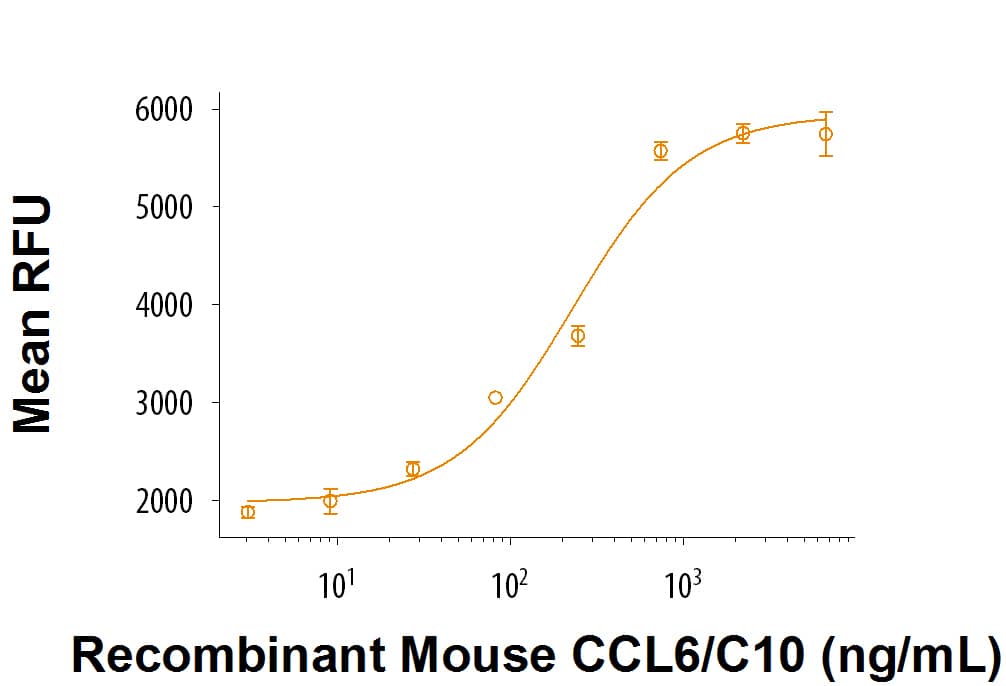Recombinant Mouse CCL6/C10 Protein
R&D Systems, part of Bio-Techne | Catalog # 487-C

Key Product Details
Product Specifications
Source
Gly22-Ala116
Purity
Endotoxin Level
N-terminal Sequence Analysis
Predicted Molecular Mass
Activity
The ED50 for this effect is 50-250 ng/mL.
Reviewed Applications
Read 1 review rated 5 using 487-C in the following applications:
Scientific Data Images for Recombinant Mouse CCL6/C10 Protein
Recombinant Mouse CCL6/C10 Protein Bioactivity
Recombinant Mouse CCL6/C10 (Catalog # 487-C) chemoattracts BaF3 mouse pro B cells transfected with human CCR1. The ED50 for this effect is 50-250 ng/mL.Formulation, Preparation and Storage
Carrier Free
What does CF mean?CF stands for Carrier Free (CF). We typically add Bovine Serum Albumin (BSA) as a carrier protein to our recombinant proteins. Adding a carrier protein enhances protein stability, increases shelf-life, and allows the recombinant protein to be stored at a more dilute concentration. The carrier free version does not contain BSA.
What formulation is right for me?In general, we advise purchasing the recombinant protein with BSA for use in cell or tissue culture, or as an ELISA standard. In contrast, the carrier free protein is recommended for applications, in which the presence of BSA could interfere.
Carrier: 487-C
| Formulation | Lyophilized from a 0.2 μm filtered solution in PBS with BSA as a carrier protein. |
| Reconstitution | Reconstitute at 10 μg/mL in sterile PBS containing at least 0.1% human or bovine serum albumin. |
| Shipping | The product is shipped at ambient temperature. Upon receipt, store it immediately at the temperature recommended below. |
| Stability & Storage | Use a manual defrost freezer and avoid repeated freeze-thaw cycles.
|
Carrier Free: 487-C/CF
| Formulation | Lyophilized from a 0.2 μm filtered solution in PBS. |
| Reconstitution | Reconstitute at 100 μg/mL in sterile PBS. |
| Shipping | The product is shipped at ambient temperature. Upon receipt, store it immediately at the temperature recommended below. |
| Stability & Storage | Use a manual defrost freezer and avoid repeated freeze-thaw cycles.
|
Background: CCL6/C10
Mouse CCL6, a member of the beta subfamily of chemokines, was initially identified as a transcript that is induced in bone marrow cells upon stimulation with GM-CSF. A human homologue for mouse CCL6 has not been identified. The mCCL6 cDNA encodes a 116 amino acid residue precursor protein with a hydrophobic signal peptide that is cleaved to yield a 95 amino acid residue mature protein. Compared to other chemokines, mCCL6 has a large N-terminal extension. The expression of CCL6 mRNA has been detected in mouse monocytes and neutrophils, where it is strongly induced upon GM-CSF stimulation. CCL6 expression has also been detected in an IL-2-dependent T cell line, where the expression is inhibited following T cell stimulation. Mouse CCL6 expression was also shown to be strongly induced by IL-4 in mouse macrophages. The gene for CCL6 has been mapped to mouse chromosome 11. The E. coli expressed CCL6 produced at R&D Systems has been shown to be a monocyte chemoattractant.
Alternate Names
Gene Symbol
UniProt
Additional CCL6/C10 Products
Product Documents for Recombinant Mouse CCL6/C10 Protein
Product Specific Notices for Recombinant Mouse CCL6/C10 Protein
For research use only
